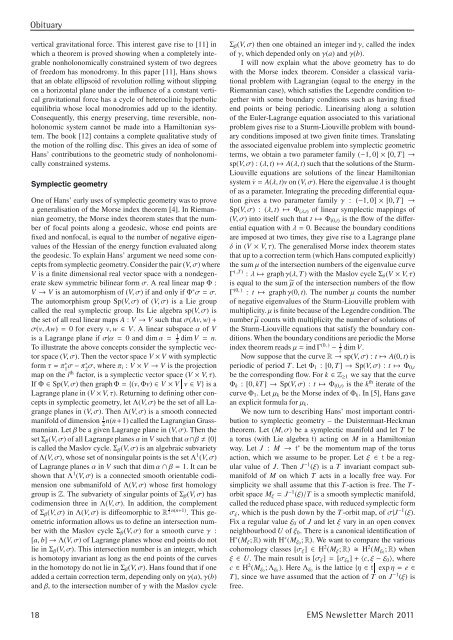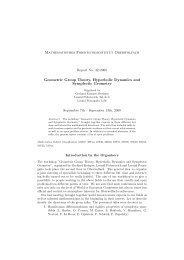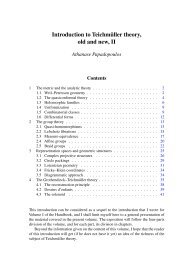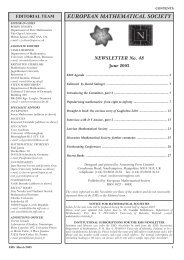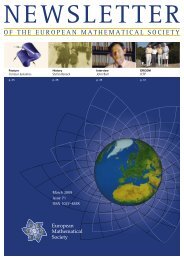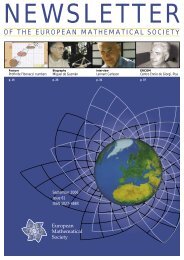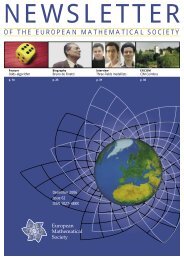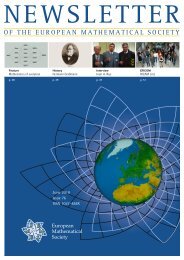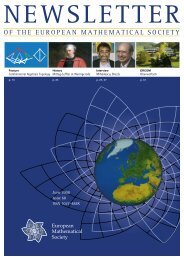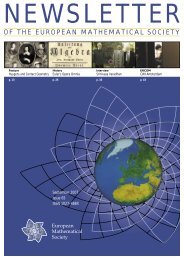Bulletin of Mathematical Sciences - European Mathematical Society ...
Bulletin of Mathematical Sciences - European Mathematical Society ...
Bulletin of Mathematical Sciences - European Mathematical Society ...
Create successful ePaper yourself
Turn your PDF publications into a flip-book with our unique Google optimized e-Paper software.
Obituary<br />
vertical gravitational force. This interest gave rise to [11] in<br />
which a theorem is proved showing when a completely integrable<br />
nonholonomically constrained system <strong>of</strong> two degrees<br />
<strong>of</strong> freedom has monodromy. In this paper [11], Hans shows<br />
that an oblate ellipsoid <strong>of</strong> revolution rolling without slipping<br />
on a horizontal plane under the influence <strong>of</strong> a constant vertical<br />
gravitational force has a cycle <strong>of</strong> heteroclinic hyperbolic<br />
equilibria whose local monodromies add up to the identity.<br />
Consequently, this energy preserving, time reversible, nonholonomic<br />
system cannot be made into a Hamiltonian system.<br />
The book [12] contains a complete qualitative study <strong>of</strong><br />
the motion <strong>of</strong> the rolling disc. This gives an idea <strong>of</strong> some <strong>of</strong><br />
Hans’ contributions to the geometric study <strong>of</strong> nonholonomically<br />
constrained systems.<br />
Symplectic geometry<br />
Σβ(V,σ) then one obtained an integer ind γ, called the index<br />
<strong>of</strong> γ, which depended only on γ(a) and γ(b).<br />
I will now explain what the above geometry has to do<br />
with the Morse index theorem. Consider a classical variational<br />
problem with Lagrangian (equal to the energy in the<br />
Riemannian case), which satisfies the Legendre condition together<br />
with some boundary conditions such as having fixed<br />
end points or being periodic. Linearising along a solution<br />
<strong>of</strong> the Euler-Lagrange equation associated to this variational<br />
problem gives rise to a Sturm-Liouville problem with boundary<br />
conditions imposed at two given finite times. Translating<br />
the associated eigenvalue problem into symplectic geometric<br />
terms, we obtain a two parameter family (−1, 0] × [0, T] →<br />
sp(V,σ):(λ, t) �→ A(λ, t) such that the solutions <strong>of</strong> the Sturm-<br />
Liouville equations are solutions <strong>of</strong> the linear Hamiltonian<br />
system ˙v = A(λ, t)v on (V,σ). Here the eigenvalue λ is thought<br />
<strong>of</strong> as a parameter. Integrating the preceding differential equation<br />
gives a two parameter family γ : (−1, 0] × [0, T] →<br />
Sp(V,σ):(λ, t) �→ Φ(λ,t) <strong>of</strong> linear symplectic mappings <strong>of</strong><br />
(V,σ) into itself such that t �→ Φ(0,t) is the flow <strong>of</strong> the differential<br />
equation with λ = 0. Because the boundary conditions<br />
are imposed at two times, they give rise to a Lagrange plane<br />
δ in (V × V,τ). The generalised Morse index theorem states<br />
that up to a correction term (which Hans computed explicitly)<br />
the sum µ <strong>of</strong> the intersection numbers <strong>of</strong> the eigenvalue curve<br />
Γ ( ,T) : λ �→ graph γ(λ, T) with the Maslov cycle Σδ(V × V,τ)<br />
is equal to the sum �µ <strong>of</strong> the intersection numbers <strong>of</strong> the flow<br />
Γ (0, ) : t �→ graph γ(0, t). The number µ counts the number<br />
<strong>of</strong> negative eigenvalues <strong>of</strong> the Sturm-Liouville problem with<br />
multiplicity. µ is finite because <strong>of</strong> the Legendre condition. The<br />
number �µ counts with multiplicity the number <strong>of</strong> solutions <strong>of</strong><br />
the Sturm-Liouville equations that satisfy the boundary conditions.<br />
When the boundary conditions are periodic the Morse<br />
One <strong>of</strong> Hans’ early uses <strong>of</strong> symplectic geometry was to prove<br />
a generalisation <strong>of</strong> the Morse index theorem [4]. In Riemannian<br />
geometry, the Morse index theorem states that the number<br />
<strong>of</strong> focal points along a geodesic, whose end points are<br />
fixed and nonfocal, is equal to the number <strong>of</strong> negative eigenvalues<br />
<strong>of</strong> the Hessian <strong>of</strong> the energy function evaluated along<br />
the geodesic. To explain Hans’ argument we need some concepts<br />
from symplectic geometry. Consider the pair (V,σ) where<br />
V is a finite dimensional real vector space with a nondegenerate<br />
skew symmetric bilinear form σ. A real linear map Φ :<br />
V → V is an automorphism <strong>of</strong> (V,σ) if and only if Φ∗σ = σ.<br />
The automorphism group Sp(V,σ) <strong>of</strong> (V,σ) is a Lie group<br />
called the real symplectic group. Its Lie algebra sp(V,σ) is<br />
the set <strong>of</strong> all real linear maps A : V → V such that σ(Av, w) +<br />
σ(v, Aw) = 0 for every v, w ∈ V. A linear subspace α <strong>of</strong> V<br />
is a Lagrange plane if σ|α = 0 and dim α = 1<br />
2 dim V = n.<br />
To illustrate the above concepts consider the symplectic vector<br />
space (V,σ). Then the vector space V × V with symplectic<br />
form τ = π∗ 1σ − π∗ 2σ, where πi : V × V → V is the projection<br />
map on the ith factor, is a symplectic vector space (V × V,τ).<br />
If Φ ∈ Sp(V,σ) then graph Φ={(v, Φv) ∈ V × V v ∈ V} is a<br />
Lagrange plane in (V × V,τ). Returning to defining other concepts<br />
in symplectic geometry, let Λ(V,σ) be the set <strong>of</strong> all Lagrange<br />
planes in (V,σ). Then Λ(V,σ) is a smooth connected<br />
manifold <strong>of</strong> dimension 1<br />
2n(n+1) called the Lagrangian Grassmannian.<br />
Let β be a given Lagrange plane in (V,σ). Then the<br />
set Σβ(V,σ) <strong>of</strong> all Lagrange planes α in V such that α∩β � {0}<br />
is called the Maslov cycle. Σβ(V,σ) is an algebraic subvariety<br />
<strong>of</strong> Λ(V,σ), whose set <strong>of</strong> nonsingular points is the set Λ1 (V,σ)<br />
<strong>of</strong> Lagrange planes α in V such that dim α ∩ β = 1. It can be<br />
shown that Λ1 (V,σ) is a connected smooth orientable codimension<br />
one submanifold <strong>of</strong> Λ(V,σ) whose first homology<br />
group is Z. The subvariety <strong>of</strong> singular points <strong>of</strong> Σβ(V,σ) has<br />
codimension three in Λ(V,σ). In addition, the complement<br />
<strong>of</strong> Σβ(V,σ) in Λ(V,σ) is diffeomorphic to R 1<br />
2 n(n+1) index theorem reads µ = ind Γ<br />
. This geometric<br />
information allows us to define an intersection number<br />
with the Maslov cycle Σβ(V,σ) for a smooth curve γ :<br />
[a, b] → Λ(V,σ) <strong>of</strong> Lagrange planes whose end points do not<br />
lie in Σβ(V,σ). This intersection number is an integer, which<br />
is homotopy invariant as long as the end points <strong>of</strong> the curves<br />
in the homotopy do not lie in Σβ(V,σ). Hans found that if one<br />
added a certain correction term, depending only on γ(a), γ(b)<br />
and β, to the intersection number <strong>of</strong> γ with the Maslov cycle<br />
(0, ) − 1<br />
2 dim V.<br />
Now suppose that the curve R → sp(V,σ):t �→ A(0, t) is<br />
periodic <strong>of</strong> period T. Let Φ1 : [0, T] → Sp(V,σ):t �→ Φ0,t<br />
be the corresponding flow. For k ∈ Z≥1 we say that the curve<br />
Φk : [0, kT] → Sp(V,σ):t �→ Φ(0,t) is the kth iterate <strong>of</strong> the<br />
curve Φ1. Let µk be the Morse index <strong>of</strong> Φk. In [5], Hans gave<br />
an explicit formula for µk.<br />
We now turn to describing Hans’ most important contribution<br />
to symplectic geometry – the Duistermaat-Heckman<br />
theorem. Let (M,σ) be a symplectic manifold and let T be<br />
a torus (with Lie algebra t) acting on M in a Hamiltonian<br />
way. Let J : M → t∗ be the momentum map <strong>of</strong> the torus<br />
action, which we assume to be proper. Let ξ ∈ t be a regular<br />
value <strong>of</strong> J. Then J−1 (ξ) is a T invariant compact submanifold<br />
<strong>of</strong> M on which T acts in a locally free way. For<br />
simplicity we shall assume that this T-action is free. The Torbit<br />
space Mξ = J−1 (ξ)/T is a smooth symplectic manifold,<br />
called the reduced phase space, with reduced symplectic form<br />
σξ, which is the push down by the T-orbit map, <strong>of</strong> σ|J−1 (ξ).<br />
Fix a regular value ξ0 <strong>of</strong> J and let ξ vary in an open convex<br />
neighbourhood U <strong>of</strong> ξ0. There is a canonical identification <strong>of</strong><br />
H∗ (Mξ; R) with H∗ (Mξ0 ; R). We want to compare the various<br />
cohomology classes [σξ] ∈ H2 (Mξ; R) � H2 (Mξ0 ; R) when<br />
ξ ∈ U. The main result is [σξ] = [σξ0 ] + �c,ξ − ξ0�, where<br />
c ∈ H2 (Mξ0 ; Λξ0 ). Here Λξ0 is the lattice {η ∈ t exp η = e ∈<br />
T}, since we have assumed that the action <strong>of</strong> T on J−1 (ξ) is<br />
free.<br />
18 EMS Newsletter March 2011


